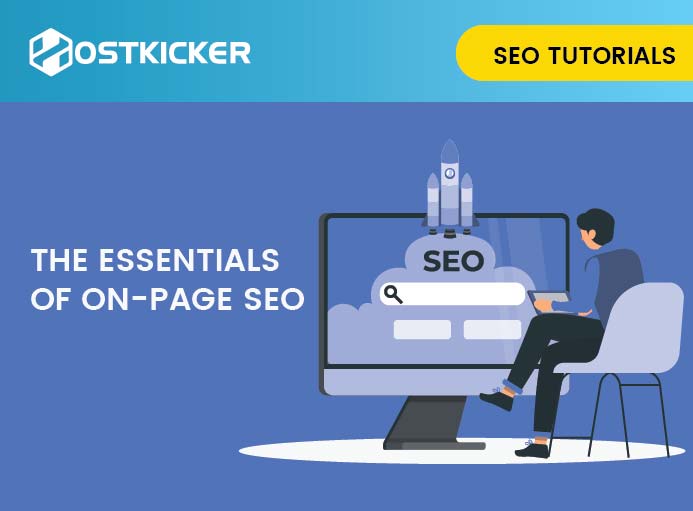The Essentials of On-Page SEO
Here, we are going to talk about the essentials of On-page SEO. Go through the article to know the key points to optimize your site.
In simplest terms, On-page SEO is whatever you do on your site.
On-Page or On-site SEO is paramount to SEO to clarify to search engines and Google what the Content on the pages of your website is concerning.
We all know that your website and its Content are for both Google and your users. You write for users, but until google understands your Content, it can not appear on the search engine result page.
Therefore, In search results, higher rankings are determined by how well Google understands your content. With increased rankings, more visitors, more conversions, and more revenue come as a reward. On-page SEO is for making a better user experience. Let us discuss it in more detail.
What does On-Page SEO Signify?
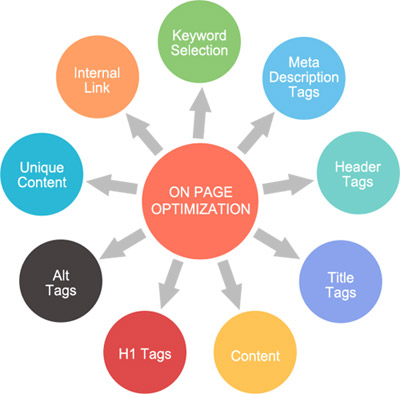
On-page SEO which is also known as On-site SEO is the approach to optimizing the content on web pages of your website for search engines and users to attain an elevated position on search result pages.
The component of on-page SEO includes Title tags, Internal links, HTML code, URL optimization, On-page Content, Images, and User experience.
You need to work on each aspect stated above to optimize your site for search engines.
On-site SEO is contrary to Off-site SEO which includes the activities you perform other than your websites, such as links building, social media, marketing, and brand building.
On-page and off-page SEO both are two faces of the same coin. Both are equally essential to perform well in search results and gather more visitors to your site. We have discussed about SEO in detail in SEO- A Basic Guide for Beginners here.
The Importance of On-Page SEO
Google constantly revises its algorithm to improve its power to understand the user’s objective when he lands on a web page and the user experience on it. According which it positions the website on search result pages. This is why on-page SEO is essential for Google as well as the owner of the site.
In addition to this, Google gives priority to the user experience on a site; therefore, you must include On-page SEO techniques in your optimizing strategies.
In addition to helping Google understand your site’s Content, an optimized page also makes it easier for Google to organize and rank it.
As per Google’s report, “the most basic signal that information is relevant is when content contains the same keywords as your search query.”
This means the relevancy of Content is determined if it holds a keyword similar to the searcher’s query.
However, this does not mean that you start crowding your Content with the keywords. You just need to mention your keyword in your Content.
These are the basics Google still considers while ranking.
The keyword density is just a single On-page SEO element. There are more added to it.
To impress and obtain a higher position in search ranking, you must optimize your content for a more satisfactory user experience, site bounce rate, Dwell time, search purpose, page loading speed, CTR, etc.
Top Essentials of On-Page SEO
1. Optimize Your Content for SEO
Now, after making it clear what On-page SEO is and what is its importance, let’s move ahead to explain how to optimize your Content.
Below are the ways you can utilize to optimize your Content.
- Within the first 100 words, Use the targeted keywords
- Use H1 Tags for the post title
- Use H2 Tags for subheadings
- The frequency of keyword
- Use of inbound and outbound links
- URL optimization
Let’s understand them one by one.
-
The Targeted Keyword
Here’s Google’s Search Advocate John Mueller’s response on the placement of targeted keyword-
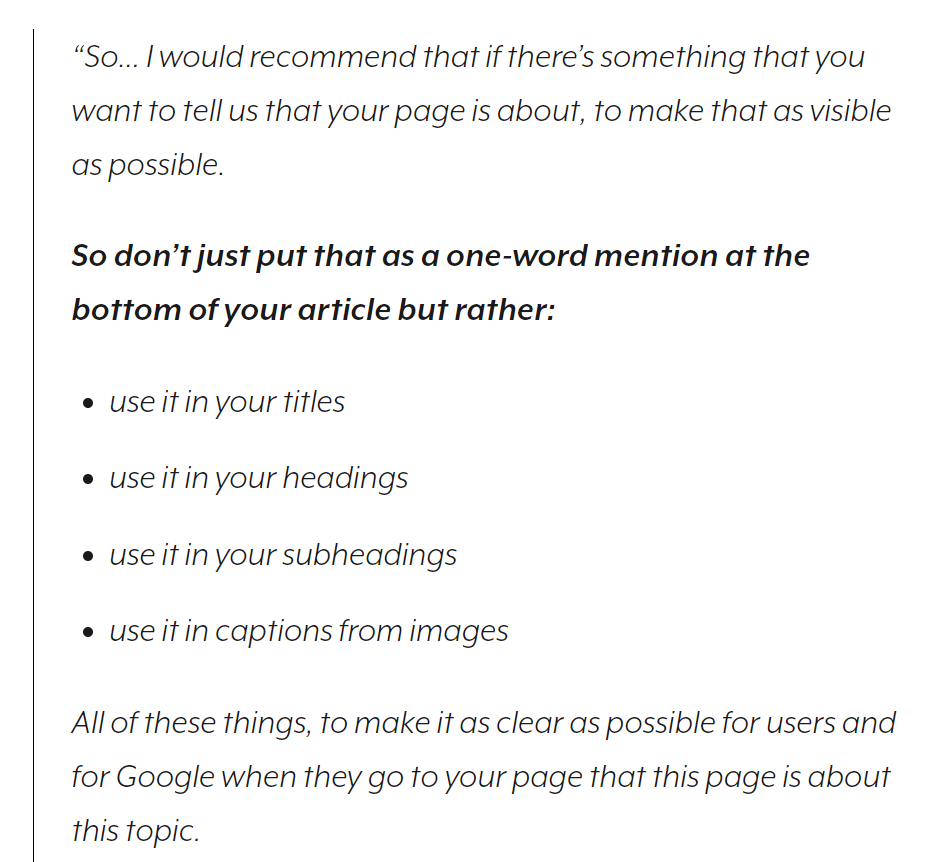
After reading this you might have got the idea what he is trying to convey. To explain him, within the first 100-150 words of your post, include the targeted keyword of that page or post.
Although it is an old on-page SEO method, it is still effective because Google focuses on the terms that appear at the beginning of your page.
This is the essential and basic thing you need to focus on. Google and users need to understand what the Content is all about in the beginning so that they continue on your page. If the page’s focus is unclear, how will Google prefer it?
Mentioning the targeted keyword, in the beginning, will be adequate to make Google understand your page. This was the first thing you needed to include in your Content for optimizing it for Google.
-
Use H1 Tags For The Post Title
The next thing for content optimization is to encase the title of the post in H1 Tags.
This is because Google understands the page structure better by analyzing the H1 Title tag of your page.

Thus, you need to encase your post title within the H1 tag.
Many website platforms, such as WordPress, wraps your blog post title in an H1 tag automatically. To confirm this, or if you use any other platform, you should check your site code to determine whether your post title is in the H1 tag and your title contains the keyword. If not, make sure you do it.
-
Use H2 Tags For Subheadings
By organizing your Content into headings and subheadings, you can signal and make Google understand the structure of your Content.
These make it clear what each paragraph is about and helps search engines to determine the importance of your page.
In addition to this, categorizing Content into headings and subheadings creates a better user experience.
In general, a complete text without headings and subheadings seems hard to grab. On the contrary, it is easy to read and understand the text with headings and subheadings, creating a pleasant user experience.
As a matter of fact, Google prefers a site that provides a better user experience.
Thus, divide your Content into headings and subheadings, use targeted keywords in some and cover it in H2 tags.
-
The Frequency of Keywords
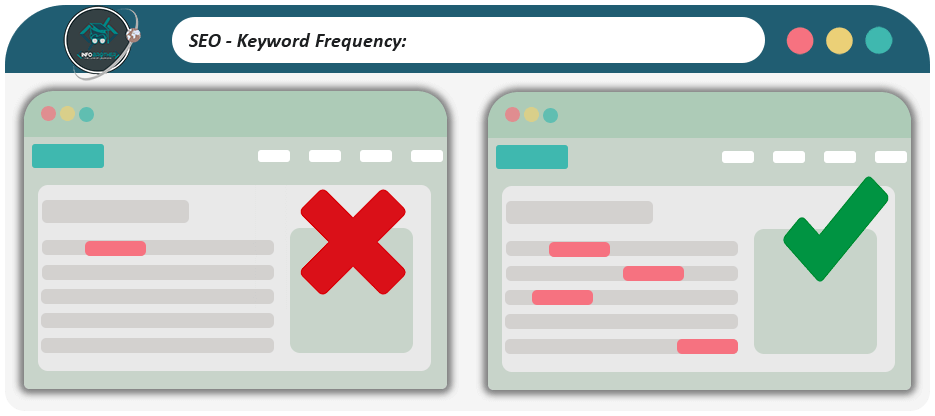
Keyword frequency is the occurrence of a targeted keyword on your page. The idea behind this is to make it clear to Google that the page is about the keyword that is repeated in the text.
We are not saying to stuff the keyword in your Content. It is just your keyword should appear all over your Content naturally.
You can yourself identify the importance of keywords in Content by analyzing this. The content in which a keyword is used once seems less relevant to the topic than the content having a keyword mentioned a few times.
Thus, you should mention your targeted keyword naturally in your content.
With your keyword, your content should also have synonyms, long-tail keywords, and the terms related to it. They can help you to create strong content and rank you higher.
-
Use of inbound and outbound links
1. Inbound or Internal linking
Another important On-page SEO factor for content optimization is Internal linking. Providing these on your page can help search engines to understand that the pages are related to each other.
Interlinking is a great way to create a connection between the pages on your website.
It also explains the relevance of your subject and the range of your topic coverage.
Additionally, it offers a great user experience. People can access more content on your site. These will help you lower your site’s bounce rate, boost conversion rate, and average time duration spent on your site.
Thus, internal linking is essential for on-page SEO to link your pages to each other. The page on your website without internal linking is considered to be orphaned.
You can also use anchor text for your internal links. The anchor text should be short, defining, and focused on the keyword you want to rank.
Internal linking is different from backlinks that help you gain authority over your site. Rather, it directs the authority and relevancy gained from backlinks all over your site.
Thus, interlinking can help you increase your position on search results if you are an authority site.
2. Outbound or External linking
Outbound links do not affect your ranking directly. Yet, links mentioning your source can create a belief in your site that you rely on authorized sources.
Therefore, you should include outbound links when needed. You can link it when mentioning someone or giving a reference to a statistic. They can help Google to know what your page is about and can affect your ranking.
You should not use anchor text with the keyword you want to rank while mentioning external links.
-
URL Optimization

Earlier, the structure of your page URL was not so popular in On-page SEO. But, URL optimization is now an essential element of it.
It helps in the SEO of the web pages of your website. URL having mention of keyword suggest what topic the page contains. On the basis of the URL, search engines, as well as your users, get to know the topic the page is about to discuss.
Thus, you should create an SEO-friendly URL for your page using the targeted keyword. URL should be clear, short and bypass stop words.
2. Optimize Your Title and Meta Description
The Next element for on-page SEO is optimizing your title and meta description.
Title and meta description also affects your search ranking; therefore, you must optimize them for SEO.
The title is one of the most significant elements for on-page SEO. It helps search engines and users to determine the purpose of your page. Search engines will rank the page relevant to the user’s query, and the users will look at it to find out if the page answers their Question.
You do not need to stuff your title with unnecessary words. Include the keyword suggesting the intent of the page. You can include modifying words such as best, fast, guide, etc., to rank for long-tail keywords.
This is an example from our latest article- The basic SEO Ranking Factors. In this we have included the keyword SEO ranking factors in the title.
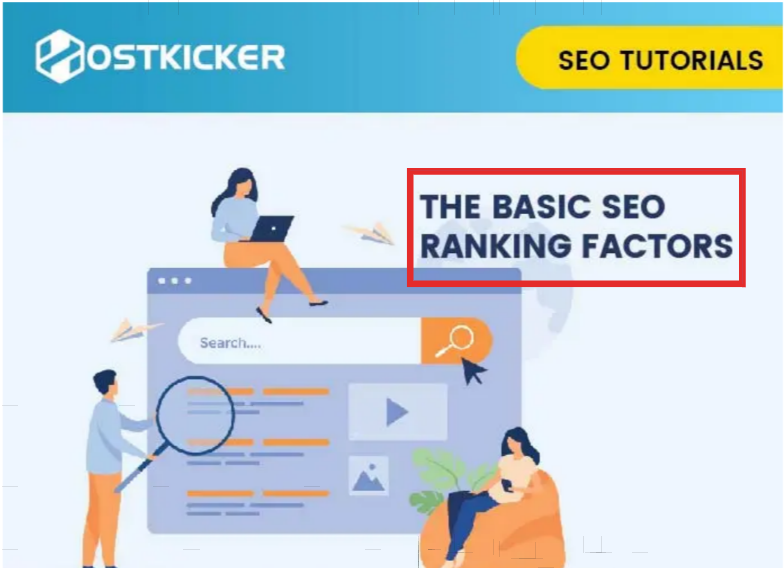
Thus, a title with keywords can facilitate good ranking, more clicks, and visitors.
On the contrary, Meta descriptions do not affect your ranking. They can catch the eye, help to provide a finer user experience, and boost your Click-Through-Rate.
Although Google may not use it, the readers read it out to get the best answer they want.
Generally, Google rewrites the meta description as per the search query, but this does not mean you skip it. You must include a Meta description in each post. Here’s Google statement on meta description-
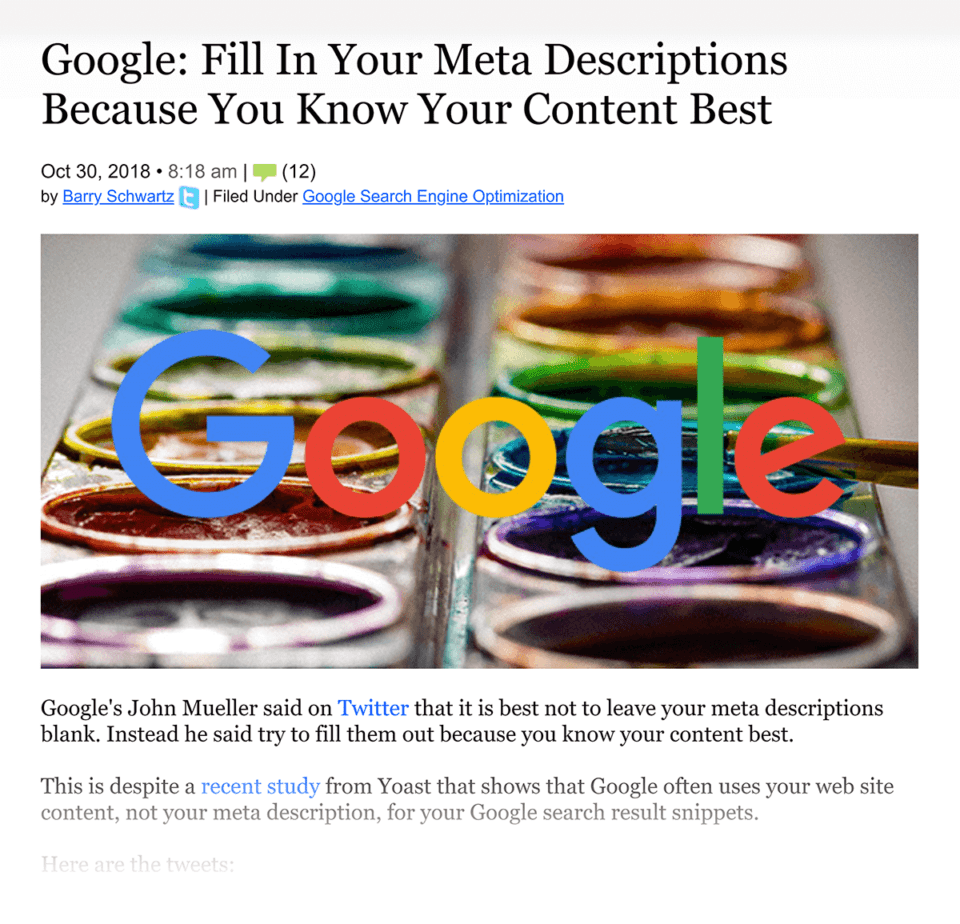
In addition, one thing you could use while writing your description is the targeted keyword. Google generally bolds the phrases or words as per the searcher’s query to help you stand out.
3. Content Outline
Content remains at the highest of all within all SEO tactics.
Writing well-optimized, useful, unique content that satisfies the reader’s need is important for getting it ranked on the search engine result page. Good copywriting is much more than the targeted keyword on your page. Your content should be exceptional, useful, and well optimized for the search objective of the users.
Google’s intent is to offer searchers what they exactly want. So Google prefers content that is more relevant, useful, and highly optimized in accordance with the searcher’s query as precisely as possible.
-
Distinctive Content
Your content should be different from what search engines already possess. It must include new information, strategy, strong content with more improved user experience, latest data, reports, or stepwise procedure of the subject.
You can include unique examples, tips and tricks, and the above-stated elements to stand out from others.
-
Useful Content
The content you offer to the users and search engines should be super useful and valuable. Since, every single day, hundreds and millions of blogs are updated every day on the internet, your content should be useful as well as unique to stand out to get noticed and caught by the search engines. To make an amazing, noticeable piece of content, you can add details, images, latest statistics, new releases, data reports, and examples that can help you catch the eye.
-
Search-friendly content
The uniqueness and usefulness of content are the keys to attaining a higher position on search engine result pages. But you can only remain there if you continue to fulfill the search purpose of the searcher.
In simple terms, until you provide what the searcher is exactly looking for, your ranking is secure on the search result page. Or else other websites will surpass you easily.
You should optimize your content to satisfy the visitor’s search intent.
Your content should be unique and stand out from others to avoid unexpected plagiarism. Plagiarism-free individual content is great for SEO, or else plagiarism can affect the reliability of your site, and you may face a penalty.
With Semrush’s SEO Writing Assistant tool, you can determine if your content is optimized for readability, keyword possibility and uniqueness, and originality.
-
Readable Content
Your content should be readable so that search engines and users can easily understand it. It does not directly affect ranking, but it is an element of on-page SEO.
A hard text is difficult to grab, resulting in a high bounce rate which will negatively affect your ranking. Below are some tips you can involve in your writing to make your content readable.
Generally, text written in active voice is more understood than written in passive voice.
Do not write a complete post in a single paragraph. Try to involve headings and subheadings, break para into smaller sections, use images and graphics and make shorter and clear sentences.

All these tips will help you to write readable content and will help you to reduce bounce rate and eventually increase your search presence.
4. Optimize Your Content for CTR
CTR stands for Click-through rate. For search engine optimization, CTR is an important aspect. CTR indicates the percentage of viewers who click on a specific link to the total number of viewers who view it.
CTR can help your Google ranking and boost visitors to your site. To optimize your content for CTR, you need to include the following things.
-
Question-based titles
Generally, as per the survey, Question-based titles have a more CTR than others. A question attracts people more by suggesting that they will probably get their answer there.
You can include this practice in the title of your posts to improve your CTR.
-
Meta Descriptions
Generally, people ignore filling the meta description because Google does not consider it a direct ranking factor. We already talked about it above.
The point is, for improving CTR, you must include a meta description for each post. People consider it for clicking a post that can positively impact your CTR.
You can find the pages missing meta descriptions and fill them in to improvise your CTR.
-
Make Your Title Catchy
The users click the Catchy titles more than the dull titles.
Do include the modifiers in the title to make them catchy and avoid the words like insane, powerful, and stop words.
-
Try adding Current Year to Title and Description
You can try to add the current year in the title and description. People are more likely to click the latest, up-to-date information than the older ones.
Including the current year in the title and description signify that your post is the latest and up-to-date.
For example: Best SEO tools title could be- The Best SEO Tools for 2022.
5. Optimize Your Images
Images are a great way to entertain and engage readers with your text. The plain text seems boring, and people do not prefer text without images. Images are a good way to clarify and make your point understood by readers.
Images add value to your information. Therefore, you need to add images to your text to engage your readers in your post.
In addition to adding images to your post, you should optimize the images for search engines.
-
Compress images
The images you use in your post should not be larger. They could take up a lot of loading time and thus affect your ranking.
You need to compress the images to improve their loading time.
There are a lot of tools present in the market, such as ShortPixel. It allows you to compress around 50 images at once.
-
The image name
The name of the image should be related to its subject except for the image address. For example, a cat’s image should be cat.jpg, not IMG_6574.jpg.
The name should be descriptive and include dashes between words. For example- Black-cat.jpg; lastly, don’t stuff keywords in your image.
-
Descriptive alt tags
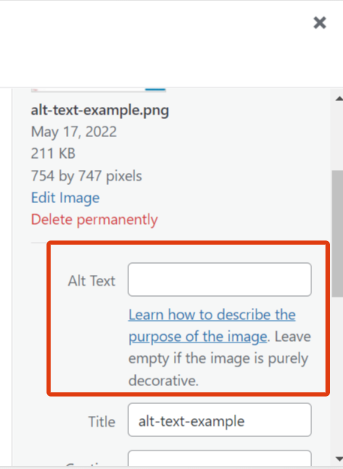
The alt tags signify to search engines what the image is about so that it values your content. The alt text improves the reach of the visitors to the image who utilize the screen readers to read out the content. Screen readers convert the content as well as the image on your site to audio. The alt text is also useful when the picture cannot load properly. It can tell what the picture is about.
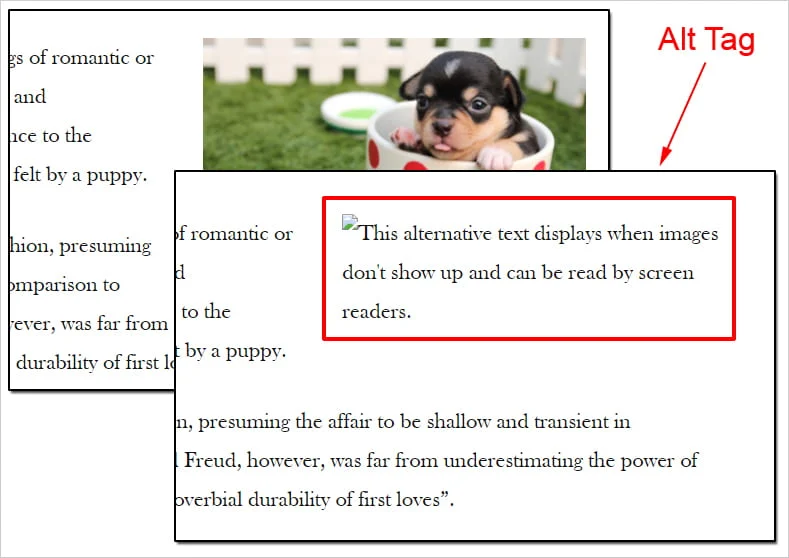
Therefore, you should include alt text to images on your post. While writing alt text to images, use keywords, make it short and simple, and be descriptive- about what the image exactly is. Avoid using the words’ Picture of’ or ‘Image of,’ it is already understood.
6. Optimize Content for User Engagement
The content you offer to the readers should be useful, unique, and engaging. Content quality is responsible for your site’s bounce rate and dwells time.
Every owner desires to enhance users’ dwell time on your site and lower the bounce rate.
Both are important because Google analyses them to determine the usefulness of the content and provide the ranking of any site on the search engine result page.
You can improve users’ engagement and experience on your site by:
- Above the fold- Try to address the topic at the very beginning before using any image in the post. Users are likely to leave the site if they do not find what they are looking for.
- Headings and subheadings- Clarify the structure of your content by using headings and subheadings. These can give a clear picture of your content so that users will want to read it further.
- Lists and bullets- Clarify your points using lists and bullets. These are easier to read and grab.
- Visuals- Add images, videos, and graphics to make your content more attractive and explanatory.
- Include CTAs- You can add call-to-action buttons to encourage readers to grab more content on your site.
- Page speed- Make sure your page loads at a faster speed to hold the reader.
The users may leave the site even if you have incorporated all the tactics in your post; however, they may want to continue the post if they find everything in a line.
- The Comment Section
To improve the user experience on your page, you may also attach people’s valuable comments on what they think of your site and content at the end of your post. Valuable Comments signify your site’s authority and trustworthiness.
Readers may find more likely to read you more.
7. Optimize your Site for Mobile
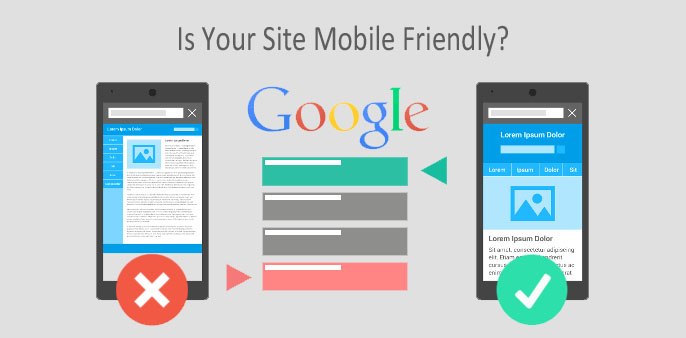
As per Google’s algorithm, Google prefers mobile-friendly site’s over non-mobile-friendly. Most of your users log into your site using their mobile phones—therefore, Google desire to provide the users with a greater user experience.
Hence, the mobile responsiveness of a site is important from the SEO point of view. Besides enhancing search traffic, it offers a greater all-around user experience. It can engage users even on a smaller screen and improves conversions.
A mobile-optimized site is the one that loads at a faster speed, is well structured, has fonts optimized for a smaller screen, and is easily navigatable.
8. Optimize Your Site and Page’s Speed
Your site and page speed is important for providing a good user experience. It can affect the bounce rate of your site and, eventually, your search ranking. It is one the most essentials of on-page SEO.
-
Page Speed
Page speed is the time taken by a page to load and display its content.
It is affected by HTML code, JavaScript files, CSS, images, and videos.
Generally, page speed is different on desktops and mobiles due to the difference in their technologies. Therefore, user experience is different on both mobiles and desktops.
-
Importance of Page Speed
It matters because page speed provides a better user experience. And on-page SEO is all about the user experience, and if a page takes much time to load, people are more likely to leave your site and move to Others. This will negatively affect your ranking as it will increase your site’s bounce rate and lower your ranking.
Generally, people are willing to grab their answers at a fast speed. Thus, you need to improve your page speed to provide a better user experience on your site.
-
Site Speed
Sometimes people consider both page and site speed to be the same. However, both are different from each other. Page speed is the time a single page takes to load its content, whereas Site speed is the average time of many pages on a site.
- Importance of Site Speed
Site speed is a direct ranking On-page SEO factor. If the speed of your site is fast, it will allow fast crawling and indexing of a website and may affect your search ranking. Faster loading sites generally have more conversion rate and lower bounce rate.
Semrush offers a Site Audit Tool you can utilize to analyze your site performance. It can also help you determine whether any page on your site is making your site slow and how you can fix it.
You can shift to a faster host or upgrade to the pro version to improve your site’s speed.
Advanced On-Page SEO Methods
After getting everything about the essentials of on-page SEO, let us outline advanced on-page SEO techniques.
-
Featured Snippets

Featured snippets are very important because they occur above the other search results. These could be definitions, tables, lists, or videos related to the search.
Since they appear at the top search result, users are more likely to click, improving CTR.
Using the Semrush Position Tracking tool, you can find out if you currently have any featured snippets. It can help you find the keyword you already have featured snippet or suggest a new opportunity for it.
![]()
You can also perform manual research on your rival’s site to find out where they have feature snippets, and you don’t. Analyze how they are answering and notice their way and performance in snippets for a particular keyword.
After that, you can organize your content again, focusing on users, and you may appear in feature snippets.
-
Schema Markup
Schema markup is a technical language that serves as a digital road map for search engine crawlers or bots. These bots and crawlers use the schema markup to determine your site and how your pages are linked to each other.
In advanced on-page SEO, schema markup is its technical part.
The content is marked by Schema markup if it is about some events, Products, People, Local Businesses, reviews, and more so that it can be displayed more filtered way.
For example, When you search for events nearby, and if the event pages have been properly schema marked, it will display a list of nearby events with dates and locations.
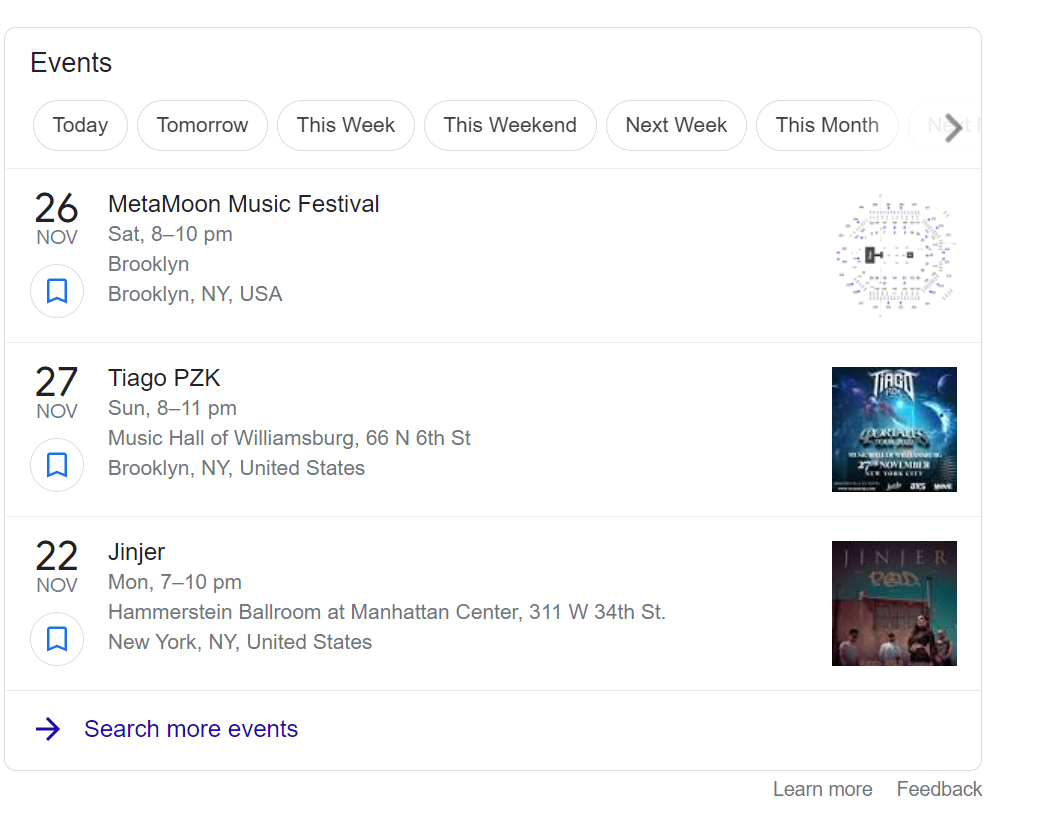
As a result, you can easily select the event you are looking for.
Websites can implement schema markup to promote events to help Google determine that it can show these events on the search result page.
The schema markup applied by websites promoting events helps Google know that they can feature these events more importantly in the SERPs.
SEO Tools
Below is a list of SEO tools you can use to optimize your on-page SEO.
- Yoast SEO
- Semrush
- Ahrefs Webmaster Tools
- Ahrefs SEO Toolbar
- MetaTags.io
- ShortPixel
- Merkle’s Schema Markup Generator
- Rich Results Test
- Moz
- On-page SEO checker
To Conclude
On-page SEO is a wider subject than we usually think. It is everything you do to improvise your search presence and ranking on search engine result pages. You need to optimize your site thoroughly to glorify. It is to optimize the essentials of on-page SEO like Title Tags, Internal links, HTML code, URL, Content, Images, and User experience.
After going through the complete article, we are sure you can now answer what On-page SEO is all about. Keep every above-stated element in your mind while creating a page for your website, and remember, satisfying search intent is the most important of all.
We hope this write-up has helped you in your on-page SEO!
